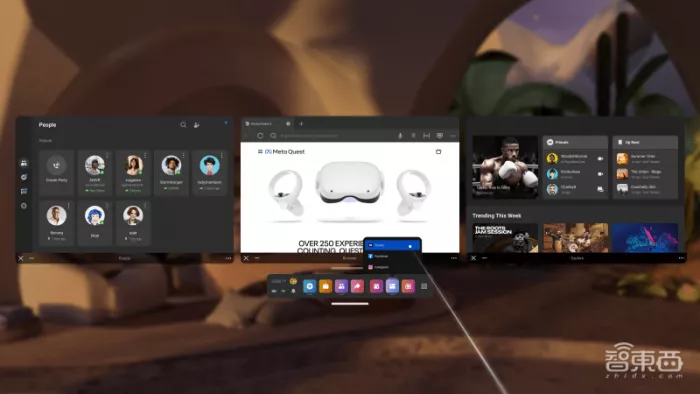According to the information, meta will release four VR head displays and two ar glasses in the next four years. Among them, the first VR head display will be released in September this year. The device code is Cambria and is expected to sell for $799 (about 5291 yuan). The device also has an iterative version with an internal code name of Funston, which will be launched in 2024. However, people familiar with the matter believe that the supply chain and epidemic situation may lead to the delayed release of products.
In just four years, meta plans to launch four VR head displays in a row, plus two ar glasses. The industry generally develops a VR / AR head display product in about 18 months. Such a radical new product release rhythm also highlights that meta is bound to win the meta universe.
1、 This year, it has entered the high-end market of VR head display and launched six new products in four years
According to the information report, at present, meta's product roadmap has announced the release plan of six head displays.
From now to 2024, meta will launch four VR head displays with internal codes of Cambria, Funston, Stinson and Cardiff.
Among them, Cambria is a high-end flagship VR head display, which may be launched in September this year. Subsequently, meta will launch a VR head display code named Stinson in 2023, which is a follow-up new product of Quest series.
▲ VR head display with internal code Cambria
In 2024, meta will launch VR head display code named Funston, which is an iterative version of Cambria, and Cardiff will be an iterative product of Stinson, a new product of Quest series.
In other words, meta will release high-end VR head displays and low-end VR head displays alternately. VR head displays with different price gears will help meta seize most of the market share of VR head displays.
At the same time, meta will also release two ar glasses with internal codes of Nazare and hypernova. Among them, Nazare will be launched in 2024, while ar glasses with stronger functions, hypernova, will be launched in 2026.
2、 VR head show highlight Cambria: it has two highlights: full-color perspective and face tracking
In October 2021, meta CEO Zuckerberg revealed for the first time at the connect 2021 conference that the high-end VR head display Cambria will be released in the second half of this year.
Although many media and analysts regard this Cambria VR headset as oculus Quest 3 or oculus Quest 2 pro, Zuckerberg himself said at the connect 2021 conference: "Cambria is a product different from Quest 2, mainly facing the high-end market." Therefore, it is still uncertain whether the VR head display code named Cambria belongs to Quest series
This VR head display has a high-resolution image display, and people can also use it to send e-mail or text messages. Within meta, Cambria is often called Arcata by researchers. The device has two highlights: full color pass through and face tracking, which can enhance the user's Mr experience.
The outward facing cameras equipped with Cambria can make the screen of VR head display present real-world scenes. The full-color perspective function of the device can not only make the VR head display present a completely virtual scene, but also make the VR head display display display the information of the real world and the virtual world at the same time, just like ar glasses.
▲ a full-color perspective idea put forward by meta at the conference
At the same time, Cambria's built-in sensors can track users' eyes and facial expressions in real time, and can help users generate users' virtual avatars in applications such as meta's horizon worlds and workrooms.
In addition, according to sources, Cambria will be heavier than oculus Quest 2 because it will carry a larger battery on the back of the head display device.
The function upgrade of Cambria equipment also makes people hold higher expectations for the use of VR head display
According to a person familiar with the matter, the internal R & D personnel of reality labs sometimes regard Cambria as "laptop for the face" or "chromebook for the face". It can be seen that meta's VR head display positioning is changing from an entertainment device to an efficiency tool suitable for office scenes**
These news also coincided with Zuckerberg's argument that "VR head display will replace PC" at the first quarter earnings conference of 2022. Zuckerberg revealed at the earnings conference that Cambria will pay more attention to the use of work scenes and will eventually replace laptops or other work equipment.
At the same time, meta compared the Cambria VR head display with Google's chromebook laptop, which also revealed that the device should have high computing power.
But is that really the case
The information mentioned that the current Cambria VR head display also uses the VR operating system based on Android. This means that users cannot use any common working software specially designed for PC through VR device, and can only enjoy the functions of some software web versions through VR web browser.
Meta seems to be aware of this problem. In the recent version update of Quest 2, it has added support for opening multiple windows in web browsers. Therefore, how to let users use some common working software through Cambria VR head display will be one of the challenges faced by meta in promoting the application of VR head display in working scenes.
▲ Quest 2 version upgrade adds multi task processing
Goldman Sachs, an investment institution, recently said in a report on AR and VR technology that although VR technology is improving, so far, VR head display has not become a just needed product for consumers, and a small number of people still use VR devices.
In other words, the current market scale of VR head display is still in the initial stage of development. Goldman Sachs also predicted that if meta allows people to work remotely through VR head display, meta's VR device sales will reach 19.4 million units in 2023.
3、 Meta has encountered three difficulties: difficult to make profits, difficult to innovate and difficult to release
Although meta revealed that it is bound to win the "meta universe" through its ambitious product roadmap, meta is faced with three dilemmas: it is difficult to release new VR products on schedule, it is difficult for VR hardware equipment to be more competitive and it is difficult for VR hardware to make profits .
The release rhythm of new products is often affected by multiple factors. For example, meta's Cambria VR head display should have been launched at the end of last year, but it was postponed until September this year due to the impact of supply chain capacity, epidemic situation and R & D progress. Therefore, meta's product roadmap is only for reference. The specific release rhythm of new products needs to be determined according to the situation. In recent years, meta's new products often fail to go online as scheduled, affecting the release rhythm.
In addition, according to the previous news summary of the information, meta's self-research plan in the field of VR has been repeatedly frustrated . Since 2022, meta has not only given up building a new VR operating system framework, but also its self-developed processor is not as good as Qualcomm's XR 2 processor.
On the one hand, this means that it is difficult for meta to open a large gap with domestic and foreign VR head display manufacturers such as Pico, HTC and lynx on the basis of VR equipment hardware. On the other hand, the frustration of the two hardware R & D teams has also caused a certain waste of resources.
"We will reassess our talent pool according to business needs and slow down the growth rate accordingly according to the financial report and expenditure," meta said in a statement on Wednesday
Meta is not only beginning to "save money", but also trying to better "open source"
"Quest 2 itself is not profitable." Guillaume chansin, director of display research at display supply chain consultants, a research company that has long tracked meta hardware, said.
Meta had hoped to make money through device related advertising or electronic services, which is similar to < a data link = "1" href = "" target = "_blank" > Microsoft's game business model. Microsoft previously mentioned that although he was in Xbox Lose money on hardware, but he can make money through games and subscription services to make up for the loss.
But now, meta only charges Quest's software developers, but it has not yet established an advertising business around its hardware devices.
Zuckerberg believes that unless VR devices, like < a data link = "1" href = "" target = "_blank" > mobile devices, reduce hardware costs with the expansion of market scale, so as to make profits through the hardware itself, advertising business will become one of the important sources of revenue for VR devices.
Conclusion: consolidate the position of the head, and meta dumped new products
From the latest product roadmap information, we can see that meta is building two product routes in the VR field. Some products are high-end flagship, trying to compete with Microsoft and Apple PK, a high-end VR product to be released soon, while another product focuses on low price and high configuration, which is used to open the scale of VR market and consolidate its leading position in VR market.
Since September 2020, meta released oculus Quest 2, the company has not released new VR products for nearly two years. The latest hardware product of meta is Ray Ban stories smart glasses released in cooperation with ray ban in December 2021. Is meta's product innovation in VR weak? The meta universe project failed? All kinds of questions have been around meta's VR equipment.
In the face of these questions, what surprises will meta's new flagship Cambria VR head display bring to users? Can this flagship product become a new entrance to the meta universe? We will continue to follow the latest developments.

